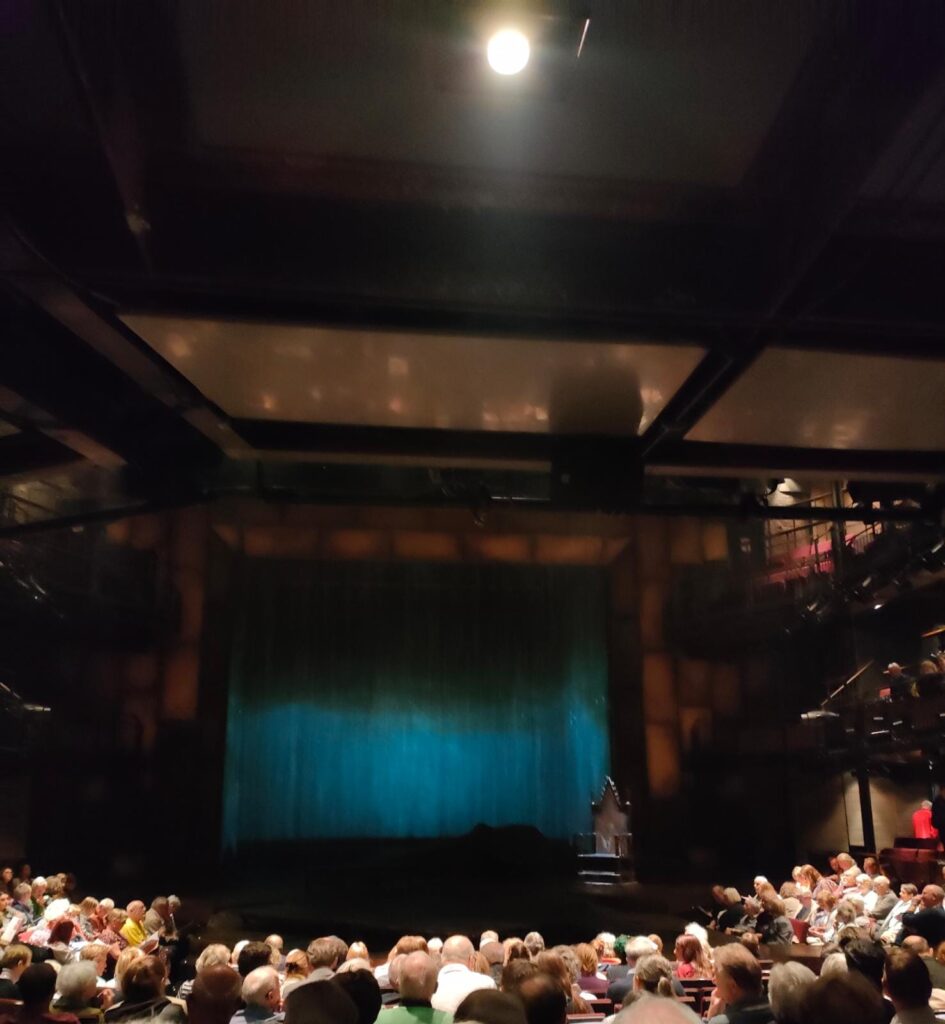Charlotte and I could scarcely believe our luck when Partner Adam at the firm sent through an email inviting us to see the final instalment of the Henry VI trilogy, director Owen Horsley’s Wars of the Roses. I had never been to the RSC before. I have cycled, walked and driven through Stratford, of course. And indeed we spent Charlotte’s birthday there, but I have never set foot in the RSC building itself. The stage was set as below, with the throne, the main object of the play, being in constant view. The throne, we noticed, sunk more gradually into the ground as the play progressed. By the end of the final act, the throne looked akin to a tombstone, which we suppose was the director’s purpose.
Opposing leaders, each asserting the legitimacy of their claim to power, sling insults and threats, unleash war. In the final section of Shakespeare’s Henry VI trilogy, advantage seesaws from side to power-and-riches-grabbing side. Then, as now, whichever faction gains temporary victory, the conclusion for ordinary people remains the same: death and desolation. Guardian
The play tells a tale of nationhood and power. It covers the Wars of the Roses between 1460 and 1471, where various conflicts saw the crown of England pass between Henry VI and Richard Plantagenet (Duke of York). Henry VI, Part 3 has one of the longest soliloquies in all of Shakespeare and has more battle scenes than any other of Shakespeare’s plays, with four seen and one reported.
The performance was extraordinary. From the first to the last, the Duke of York (Oliver Alvin-Wilson) was compelling, emotive, and piercing. Henry VI (Richard Kant) was the picture of mental decline, hammered repeatedly by his losses to the point where he compares a Scottish shepherd to a King before being locked in the tower of London. Queen Margaret (Minnie Gale) was perturbing par excellence, with a memorable screaming soliloquy towards the end. But the best part of the whole play was the gay King of France, with full frilly silk gown and affected mannerisms. Charlotte, however, believes that the minor, light relief provided by the King of France (not even noted in the cast list on the RSC website) was not the height of this masterpiece.
I (Charlotte) believe that the best part of the play for me, if there can be one best part, was the touching moment Cedric mentions above, when King Henry lies on the stage and praises the wisdom and peace of a shepherd over the splendour of a king. The King has fled, leaving his wife furious over his agreement to disinherit their only son in order to keep the crown only for the duration of his own life. His low moment allows sober reflection to produce a thought a lot of us must have had: couldn’t my life be simpler? Don’t our systems of power overcomplicate things? Ironically, the King regains some of his haughtiness immediately afterwards when he insults two commoners that stumble upon him and recognise him as the exiled monarch, but this doesn’t detract from the pathos of the soliloquy.
The impression of the chaos of war is the most powerful aspect of director Owen Horsley’s Wars of the Roses, one of two new RSC productions based on the Henry VI plays . Design (mud and ramps), costumes (armour, chainmail, robes), digital projections (stage battles filmed live and projected huge on to ribboned curtains), music and sound (clashing percussion and nerve-taut strings), along with performances (comradely chants, battle-weary panting, groaning of the mortally wounded) combine to emphasise the brutality and futility of violence. Guardian
I have heard said that there is no space like the RSC to see Shakespeare performed. I (Cedric) am in full agreement with this. The set was phenomenal, with grey rock in the centre, a raised platform to the left and sinking throne on the right, eventually, as has been said above, giving the appearance of a grave stone. The play’s splendour was further heightened by the live camera work. A chain link curtain ascended and descended in the back of the stage, onto which were projected words, dates and even live footage from cameras brought in to film pertinent parts of the play. For example, the touching part where a soldier, after a battle, is about to loot the corpse of a vanquished foe, only to discover it is his son, is both played out on stage and his face projected onto the metal curtain above the stage. This added to the harrowing scene, depicting with searing detail the reality of war.
This play and this production were unquestionable masterpieces. We (Cedric and Charlotte) highly recommend you attend it forthwith!
The play will show at the RSC until 4 June.



